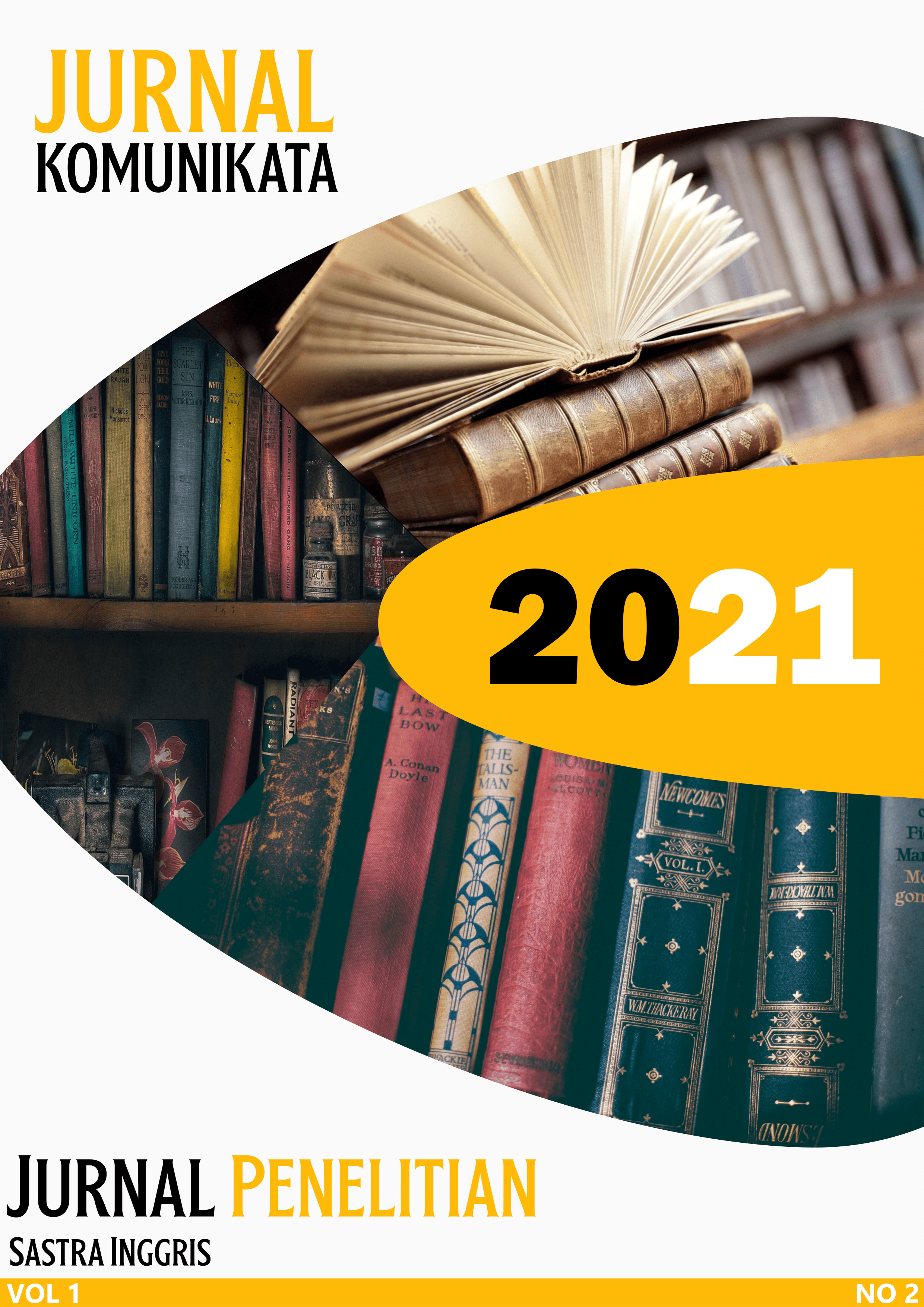THE DYNAMIC OF IDENTITY FORMATION OF MICHELLE JORDAN CHARACTER IN WOMAN THOU ART LOOSED
Kata Kunci:
identity, identity formation, relationship, dynamic.Abstrak
In this thesis, the writer discusses important aspect in psychological issue as describe in Michelle Jordan character. To answer the problem structurally, the writer arranged the theoretical framework by discussing about theory and approach. The main purpose in this research is to disclose the dynamics of identity formation as seen in Michelle Jordan Character within T.D Jakes work, Woman Thou Art Loosed. The theories that the writer applied are the object relations theory. In object relation theory which is divided in three phases; they are attachment, rejection and frustration. Meanwhile the writer emphasized on one approach that is psychological approach to disclose psychological issue which is the dynamic of identity formation. In addition, this analysis applied descriptive qualitative method clearly about the problem by using words. The result of this analysis shows that Michelle Jordan’s identity formation which is dynamic affected by her life experiences as identification within her relationship with the object (family, group, and peer) to determine the identity. Michelle Jordan’s identity as lovable influence by attachment, identity as gloomy influence by rejection, and identity as evil influence by frustration. Those significant changes of Michelle Jordan’s identity seen through her relationship.
Referensi
Abdullah, A., & Masthura, M. (2021). Pemanfaatan Sari Nenas Sebagai Sumber Energi Alternatif Pembuatan Bio-Baterai. CIRCUIT: Jurnal Ilmiah Pendidikan Teknik Elektro, 5(1), 51. https://doi.org/10.22373/crc.v5i1.8494
Adiyanto, A., & Febrianto, R. (2020). Authentication Of Transaction Process In E-marketplace Based On Blockchain technology. Aptisi Transactions On Technopreneurship (ATT), 2(1), 68–74. https://doi.org/10.34306/att.v2i1.71
Ambarwari, A., Adrian, Q. J., & Herdiyeni, Y. (2020). Analysis of the Effect of Data Scaling on the Performance of the Machine Learning Algorithm for Plant Identification. Jurnal RESTI (Rekayasa Sistem Dan Teknologi Informasi), 4(1), 117–122.
Ayu, M. (2020). Online learning: Leading e-learning at higher education. The Journal of English Literacy Education: The Teaching and Learning of English as a Foreign Language, 7(1), 47–54.
Budiman, A., Samsugi, S., & Indarto, H. (2019). SIMULASI PERBANDINGAN DYNAMIC ROUTING PROTOCOL OSPF PADA ROUTER MIKROTIK DAN ROUTER CISCO MENGGUNAKAN GNS3 UNTUK MENGETAHUI QOS TERBAIK. Seminar Nasional Teknik Elektro, 4(1), 16–20.
Fahrizqi, E. B., Agus, R. M., Yuliandra, R., & Gumantan, A. (2021). The Learning Motivation and PhFahrizqi, E. B., Agus, R. M., Yuliandra, R., & Gumantan, A. (2021). The Learning Motivation and Physical Fitness of University Students During the Implementation of the New Normal Covid-19 Pandemic. JUARA: Jurnal Olahraga, 6(. JUARA: Jurnal Olahraga, 6(1), 88–100.
Febrian, A., & Fadly, M. (2021). The Impact of Customer Satisfaction with EWOM and Brand Equity on E-Commerce Purchase Intention in Indonesia Moderated by Culture. Binus Business Review, 12(1), 41–51. https://doi.org/10.21512/bbr.v12i1.6419
Fitri, E., & Qodriani, L. U. (2016). A study on flouting maxims in Divergent novel. Teknosastik, 14(1), 32–40.
Gazali, F., & Yusmaita, E. (2018). Analisis Prior Knowledge Konsep Asam Basa Siswa Kelas XI SMA untuk Merancang Modul Kimia Berbasis REACT. Jurnal Eksakta Pendidikan (Jep), 2(2), 202. https://doi.org/10.24036/jep/vol2-iss2/249
Gulö, I. (2018). How Nias Sees English Personal Pronouns Used as Preposition Objects. LINGUA: Jurnal Bahasa Dan Sastra, 18(2), 147–156.
Jobli, M. I. Bin, Monir, D. K. B., & Peng, K. K. (2011). Analysis of waste thermal energy from banana peels using decomposition process for heat generation. 2011 IEEE 1st Conference on Clean Energy and Technology, CET 2011, 19–22. https://doi.org/10.1109/CET.2011.6041452
Kistijantoro, A. I. (2014). Vitality based feature selection for intrusion detection. 2014 International Conference of Advanced Informatics: Concept, Theory and Application (ICAICTA), 93–96.
Lina, L. F., & Setiyanto, A. (2021). Privacy Concerns in Personalized Advertising Effectiveness on Social Media. 5(December 2020), 147–156.
Liu, C., Zhou, Q., Li, Y., Garner, L. V., Watkins, S. P., Carter, L. J., Smoot, J., Gregg, A. C., Daniels, A. D., Jervey, S., & Albaiu, D. (2020). Research and Development on Therapeutic Agents and Vaccines for COVID-19 and Related Human Coronavirus Diseases. ACS Central Science, 6(3), 315–331. https://doi.org/10.1021/acscentsci.0c00272
Mardinata, E., & Khair, S. (2017). Membangun Sistem Informasi Pengelolahan Data Nasabah. 17(1), 27–35.
Mertania, Y., & Amelia, D. (2020). Black Skin White Mask: Hybrid Identity of the Main Character as Depicted in Tagore’s The Home and The World. Linguistics and Literature Journal, 1(1), 7–12.
Mulyanto, A., Borman, R. I., Prasetyawan, P., & Sumarudin, A. (2020). Implementation 2D Lidar and Camera for detection object and distance based on RoS. JOIV: International Journal on Informatics Visualization, 4(4), 231–236.
Mulyanto, A., Susanti, E., Rossi, F., Wajiran, W., & Borman, R. I. (n.d.). Penerapan Convolutional Neural Network (CNN) pada Pengenalan Aksara Lampung Berbasis Optical Character Recognition (OCR). JEPIN (Jurnal Edukasi Dan Penelitian Informatika), 7(1), 52–57.
Pranoto, B. E., & Suprayogi, S. (2020). A Need Analysis of ESP for Physical Education Students in Indonesia. Premise: Journal of English Education, 9(1), 94–110.
Reranta, R. C., & Gulö, I. (n.d.). Short Notices in Bandar Lampung: Errors and Variations.
Rido, A., & Sari, F. M. (2018). Characteristics of classroom interaction of English language teachers in Indonesia and Malaysia. International Journal of Language Education, 2(1), 40–50.
Roger S. Pressman, P. D. (2012). Rekayasa Perangkat Lunak - Buku Satu, Pendekatan Praktisi. In Software Engineering : A Practitioner’s Approach, Seventh Edition. https://doi.org/10.1098/rspb.2012.1110
Saifuddin Dahlan, F. H. (2013). THE INFLUENCES OF PERSONALITY AND COGNITIVE PERCEPTION TOWARDS THE STUDENTS’INTENTION TO USE DATABASE SOFTWARE AT THE COMPUTERIZED ACCOUNTING VOCATIONAL COLLEGES IN LAMPUNG PROVINCE. Universitas Lampung.
Septiyana, L., & Aminatun, D. (2021). THE CORRELATION BETWEEN EFL LEARNERS’COHESION AND THEIR READING COMPREHENSION. Journal of Research on Language Education, 2(2), 68–74.
Sulistiani, H., Muludi, K., & Syarif, A. (2019). Implementation of Dynamic Mutual Information and Support Vector Machine for Customer Loyalty Classification. Journal of Physics: Conference Series, 1338(1), 12050.
Sulistiani, H., Muludi, K., & Syarif, A. (2021). Implementation of Various Artificial Intelligence Approach for Prediction and Recommendation of Personality Disorder Patient. Journal of Physics: Conference Series, 1751(1), 12040.
Yunara, Y. Y., & Kardiansyah, M. Y. (2017). Animus Personality in Martin’s A Song of Ice and Fire: A Game of Thrones. Teknosastik, 15(1), 7–13.


